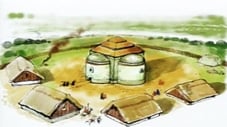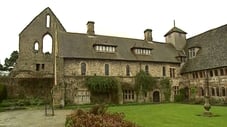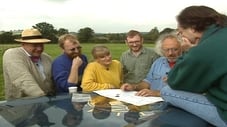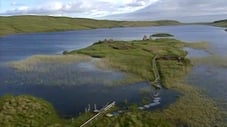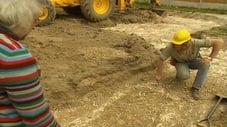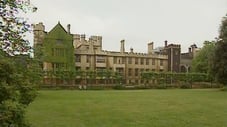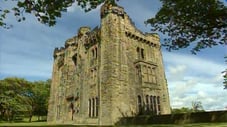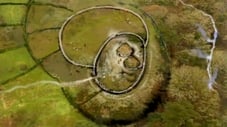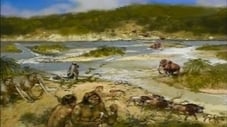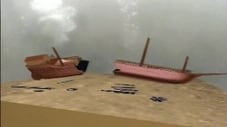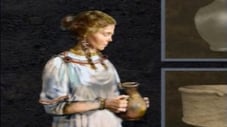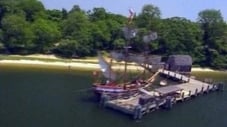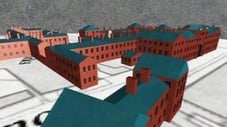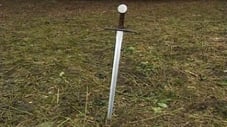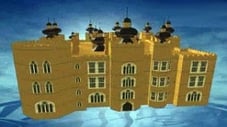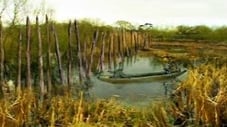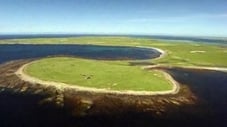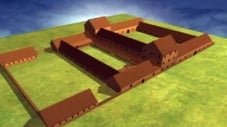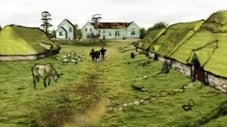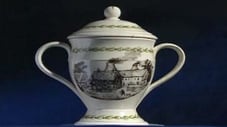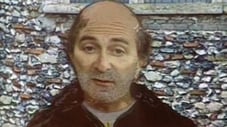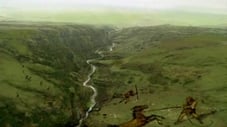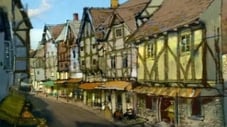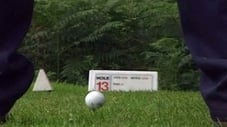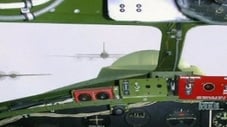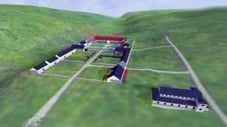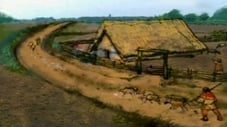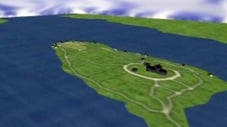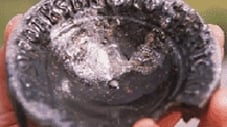
Time Team (1994)
← Back to main
Sue Francis as Self - Graphic Artist
Episodes 42
The Guerrilla Base of the King - Athelney, Somerset
In this first ever episode of Time Team, Tony and the team travel to Athelney in Somerset to investigate a series of hills (once islands in a bog) that became Alfred The Great last defensive positions after a series of losses to invading Viking forces. It is also the place Alfred began the great rally that saw him re-conquer most Wessex and laid the foundations of the nation that was to become England.
Read MoreOn the Edge of an Empire - Ribchester, Lancashire
Ribchester in Lancashire has been known for some time as a site of a Roman fort. The Time Team arrive in the town to answer two questions, one is to consolidate all the previous excavations on the site, and the second to define the outline of a possible older wooden fort that is thought to have been in the area.
Read MoreThe New Town of a Norman Prince - Much Wenlock, Shropshire
The Time Team go to the small town of Much Wenlock, after they receive a letter from a resident explains a recent excavation uncovered possibly the oldest house in the town. What they discover is the remains of an old Saxon village transitioning into a larger newer Norman settlement.
Read MoreThe Fortress in the Lake - Llangorse Lake, Powys
The Time Team travel to Brecon Beacons in Wales, they have come to investigate a small man-made island in Llangorse Lake. Locals tell many strange legends including hearing the sounds of Church bells echoing across the body of water at night. The Team want to know who built the island and try to find evidence to support the stories of it eventual fall into disuse.
Read MoreLord of the Isles - Finlaggan, Islay
The Time Team travel to a group of islands on the western side of Scotland to investigate a culture known as the "Lords of the Isls" - who ruled the islands 1000 years ago. The team joins a group from the Scottish National University who've been working in the area for some five years uncovering the history of these people. What the Time Team discovers throws the whole excavation into a new light and suggests people may have lived in the area thousands of years prior.
Read MoreThe Saxon Graves - Winterbourne Gunner, Wiltshire
The Time Team visit Hylton Castle near Sunderland. A local group want to redevelop the local area as a tourist attraction but don't want to disturb any hidden structures.
Read MoreThe Lost Villa - Tockenham, Wiltshire
Tockenham village, in the Wiltshire countryside. Despite the fact that there are no Roman remains in Tockenham, the village's 15th century church, St Giles, has a small pagan Roman statue embedded in one of its outer walls.
Read MoreThe Archbishop's Back Garden - Lambeth Palace, London
The Time Team traveled to Lambet Palace in the heart of London. They are trying to unravel the enigma of why the Romans crossed the Thames in a different area to where they developed the city. The team needs to employ some extreme archeology to try an understand what the Romans where thinking.
Read MoreMedieval Dining Hall - Hylton Castle, Sunderland
The Time Team travel to Winterbourne Gunner in Wiltshire to investigate a housing development that has come to a halt because of an alarming number of Saxon graves found in the area They successfully work their way through the maze of finds but in doing so discover what seems to be a whole new layer of history in the town.
Read MorePrehistoric Fogou - Boleigh and Treveneague, Cornwall
Recorded between 17 and 19 March 1995, the team try to discover what a 2000-year-old underground chamber (fogou) beneath Jo May's garden was used for. Dowser Hamish Miller shows the extent of the fogou beneath the lawn, and Tony tries his hand at dowsing. But Mick is skeptical, preferring to rely on the geophysical survey. They are also trying to find the Iron Age settlement that would have adjoined the fogou. Joining the team are archaeological geophysicist Susan Ovenden, and county archaeologist Nick Johnson. The programme includes an experiment in extracting pure tin from the local stream.
Read MoreHunting for Mammoth - Stanton Harcourt, Oxfordshire
Recorded between 21 and 23 April 1995, in this episode the team go to a gravel pit that is soon to become landfill, where they attempt to unearth 200,000-year-old remains of mammoths and other prehistoric animals. Gravel pits are typical sites for paleolithic remains. But the chances of finding evidence of any prehistoric peoples are remote. Joining the team are Christine Buckingham, Kate Scott, and palaeontologist Russell Coope. Wood anatomist Rowena Gale tries to match ancient and modern wood samples For this episode the team are joined by archaeologist Kate Scott and geologist Christine Buckingham.
Read MoreVillage of the Templars - Templecombe, Somerset
Recorded between 26 and 28 May 1995. A 13th century picture of Christ, strikingly similar to that on the Turin Shroud, has turned up. It's believed to belong to the Knights Templar, a medieval order of monks who gave their name to the village of Templecombe. The team investigate a manor house thought to be on the site of a monastery. What's left of the monastery, and who were the Templars anyway? So far all the evidence seems to be outside the house, where Phil and the team have already dug up pieces of encaustic tile. Carenza and Robin are doing some research among the documents.
Read MoreA Wreck of the Spanish Armada - Teignmouth, Devon
Recorded between 30 June and 2 July 1995. 20 years ago a teenage boy discovered a 400-year-old bronze cannon in water close to the south Devon coast. Nobody has yet identified the ship it belonged to. Will there be enough left of the wreck to identify it? As usual, Time Team have only three days to find out. Tony is looking forward to getting into his diving suit. But the team cannot dive until the wreck's archaeological supervisor, Chris Preece, arrives. Meanwhile the wreck's finder, Simon Burton, tells his story. Undeterred by disappointing geophysics results, the divers go ahead with their search in murky water. On land, armoury expert Nicholas Hall demonstrates the cannon. Ultimately Robin comes up with a theory about the ship's origin and purpose.
Read MorePalace of the Irish Kings - Emain Macha (aka Navan Fort), County Armagh
Recorded between 7 and 9 April 1995, the team are at Emain Macha (aka Navan Fort), County Armagh, where according to Celtic legends three palaces were built. The evidence of two have been found and the team try to find evidence of the third.
Read MoreTreasures of the Roman Field - Lavenham, Suffolk
Recorded between 28 and 30 August 1995. The team arrive in a large square field about 20 miles from Colchester. This is an area typically rich in Roman activity. Several remains have previously been dug up, including coins, an elaborate key, and Samian ware. Adrian Thorpe, the farmer, wants to know more. The indications are of a settlement with high status buildings, maybe timber-framed. With recycled fragments of genuine Roman glass, fired up in a homemade furnace, glassblower Ed Iglehart creates an authentic conical beaker. Among hundreds of finds is a metal owl brooch. They are joined by Jude Plouviez from Suffolk County Council, Roman specialist Lindsay Allason-Jones, environmental archaeologist Peter Murphy, and coin specialist Daphne Briggs.
Read MoreMaryland, USA - St. Mary's City, Maryland, USA
Recorded between 17 and 19 May 1996, the team go to St. Mary's City in Maryland to work with American archaeologists to look for evidence of the city founded by English colonists in 1634. Different archaeological styles between American and British addressed, with the Time Team conducting geophys onsite for the first time. Finds: two buildings, including fort.
Read MoreMystery of the Cornish Skeletons - Launceston, Cornwall
Filmed between 22 and 24 March 1996. A local landowner has discovered human bones while installing water pipes. It is known to be the site of a former leper hospital, and a major crossing between Devon and Cornwall. How much more can Time Team discover about it? Phil uncovers a complete skeleton which has received a Christian burial, and which Osteoarchaeologist Margaret Cox identifies as a young adult female. She also examines the bone fragments for signs of leprosy. Juliet Griffin makes a herbal poultice to dress the lepers' wounds. Robin Bush looks at the 13th century charter granted to the hospital.
Read MoreSteam-Powered Mint - Soho, Birmingham
Recorded between 5 and 7 April 1996, this episode sees the team try to discover what remains of Matthew Boulton's Soho Manufactory, an important factory and home to the world's first steam-powered mint, during the Industrial Revolution. They are joined by industrial archaeologist George Demidowicz.
Read More8th Century Church - Govan, Glasgow
Filmed from 14 to 16 June 1996, in this episode the team try to find out why the graveyard of a 19th century church features large tortoise-shaped gravestones dating back to the Dark Ages. The team are joined by Scottish prehistorian Anna Ritchie and archaeologist Steve Driscoll.
Read MoreNorman and Medieval Castles - Malton, North Yorkshire
Recorded between 5 and 7 July 1996, the team try to discover a medieval castle and a Jacobean mansion. Barry Scott (bladesmith) makes a sword using traditional techniques, and the Conquest Society demonstrates hand-to-hand combat with authentic armour and chainmail.
Read MoreRoman Villa - Netheravon, Wiltshire
Filmed from 2 to 4 August 1996, this episode looks for a Roman villa that was first partially discovered 90 years before by William Hawley. Part of the site - a former army barracks - is covered in concrete, which at least protects what is underneath. But as they don't know exactly where the villa is, it could be a problem for both the diggers and the geophysics team. The team are joined by Duncan Coe (county archaeologist), Mark Corney (Roman buildings expert) and Lindsay Allason Jones (Roman finds). At the end of day two Lindsay supervises an al fresco Roman-style meal. By day three they have the bare outline of a very substantial, high-status building complete with mosaic floors and central heating. But then unfortunately the time runs out.
Read MoreRichmond Palace - Richmond, Surrey
Filmed between 25 and 27 July 1997. The team are camped on an immaculate suburban lawn next to the Thames. They are searching for the now vanished Richmond Palace, site of the death of Elizabeth I. But amazingly nobody is exactly sure of its whereabouts. The first task is to dig up the lawn under the supervision of landscape gardener Martin Whitaker. Immediately they find evidence of a substantial high status Tudor building. They are joined by palaces expert Simon Thurley and local historian John Cloake. Tudor expert Hazel Forsyth shows Carenza how to make a pomander. Plants from the garden are used by Maria Lis-Balchin to brew up some Elizabethan perfume. The property owner was The Baron van Dedem.
Read MoreBronze-Age Trackway - Greylake, Somerset
The team go to the Somerset levels in search of a 4,000-year-old wooden trackway. The quickest way to get across the marshes that used to exist here in the Bronze and Iron Ages was across wooden walkways. Now the team hope to find evidence of these footbridges.
Read MoreViking Graves - Orkney, Scotland
The team go in search of evidence of the invasion of the Vikings, and its influence on ancient Britain. The team travel to the Orcadian island of Sanday to try to find out whether four mysterious mounds there are evidence of a Viking settlement or even a Viking burial site.
Read MoreRoman Villa - Turkdean, Gloucestershire
3 days of live excavation. The weekend ended with evidence of a Romano-British villa complex that is one of the largest ever found in Britain. This programme is an edited version of that weekend. They discover that the villa dates from the very first days of the Roman occupation. Amongst their new finds is an entire, untouched Roman water course.
Read MoreCopper-Age Settlement - Mallorca, Spain
Time Team goes abroad to tackle one of its most challenging sites. They search for evidence of one of the most enigmatic cultures in the world on the Spanish island of Mallorca. The Beaker people flourished in Europe around 4,000 BC, but there is very little evidence of their civilisation, which is thought to have made the first use of metal.
Read MoreAston Eyre Farmhouse - Aston Eyre, Shropshire
Filmed between 27 and 29 June 1997, the team go to Shropshire and search for a complex of medieval buildings in Aston Eyre, where the only remaining building is a farmhouse that used to be a gatehouse. They are joined by archaeologist Mark Horton and archivist Paul Stamper. Tree rings expert Dan Miles tries to get some dates from beams in the gatehouse. Ian Pritchett demonstrates a traditional lime kiln. Finds: potential earlier structure found at end of day three, but time ran out before they could determine what it was.
Read MoreCathedral Hill - Downpatrick, County Down
Recorded between 19 and 21 February 1997, the team look for the early monastic buildings on Cathedral Hill, where according to legend St. Patrick built a monastery and was buried. They are also digging up medieval finds, including roof tiles and glass, which indicate a high status building. They soon identify the large double ditch which originally enclosed the monastery complex. Victor tries his hand at medieval calligraphy and helps create an illuminated manuscript with a portrait of a familiar face, complete with hat and feather. We also see some vellum making.
Read MoreDeserted Medieval Village - High Worsall, North Yorkshire
Filmed between 10 and 12 October 1997, Time Team go to High Worsall, near Middlesbrough, a village that almost completely disappeared hundreds of years ago. Finds: 14th century buildings and manor house, pristine spindle whorl. Experimental demonstration: fishing and cooking caught fish. Also, historians Robin Bush and Dawn Hadley are followed while they research the village and create a timeline.
Read MoreWedgwood's First Factory - Burslem, Stoke-On-Trent
The Team are in Burslem, Stoke-on-Trent, to investigate what remains of Josiah Wedgwood's first factory and to discover what pottery he was making there. They find evidence of several centuries of potting and bottle kilns, including a time capsule of the pottery of Enoch Wood & Sons. Experimental archaeology: a replica creamware vase.
Read MoreBack Garden Roman Finds - Papcastle, Cumbria
The team are in North West England, investigating Roman finds and a possible Roman building, unearthed in a family's back garden. The house is just 100 metres from a Roman fort, and south-west of the end of Hadrian's Wall. Geophysics are using state-of-the art Swedish radar equipment, to detect foundations beneath two metres of soil. A fragment of bronze mirror hints at a domestic settlement, a vicus, that would have sprung up next to the fort. But the diggers are finding plenty of archaeology, indicating much larger and more organised Roman building, possibly a city. Through the expertise of potter Gilbert Burroughes, the team are going to try to make a Samian ware bowl during the three days. The team are joined by Roman specialist Lindsay Allason-Jones.
Read MoreDominican Friary Church and Norman Cathedral - Thetford, Norfolk
Time Team have been invited by pupils of Thetford Grammar School in Norfolk, to investigate the remains of a Dominican friary church and a 1,000-year-old Norman cathedral, in their playground. There is much interest from the pupils when the team excavate human bones. Ecclesiastical historian Janet Burton describes the origins of the Dominican Order. Stonemason Simon Williams gives a practical demonstration of medieval wall-building using knapped flint and lime mortar. Stained glass expert David King confirms medieval dates for fragments from the friary. The junior school makes a timeline frieze, complete with felt bishops and monks. It all ends in an open evening for parents.
Read MoreCooper's Hole - Cheddar Gorge, Somerset
Investigation, at the invitation of the cave's owner, the Marquess of Bath, to see if there is evidence of Palaeolithic human activity in the cave. This may be among the oldest homes in England. The ultimate aim is to get the site scheduled and thus protected from unofficial damage. However it soon becomes clear there is a lot of preparatory work involved. They are joined by palaeontologist Andy Currant, and cave archaeologists Larry Barham and Kate Robson Brown. Caver Malcolm Cotter directs them to a cache of bones; but the tunnel is blocked by sediment from flooding.
Read MoreMedieval Plympton - Plympton, Devon
In the 12th century many towns were designed and laid out on regular lines. The people of Plympton believe there is enough evidence to plot the layout of the medieval town which surrounds the ruins of their castle, and which was formerly owned by the immensely powerful and wealthy de Redvers family. As usual, Time Team have three days to find it. Back gardens and interiors will provide the clues, rather than frontages which have probably been altered many times in the last 800 years. So they will need plenty of help from local householders. They are joined by Plymouth city archaeologist Keith Ray and dendrochronologist Robert Howard.
Read MoreTudor Dockyard - Smallhythe, Kent
Looking for evidence of a 15th century dock, the team are in Small Hythe. The dock was once next to the mile-wide River Rother but its location is now an overgrown field, ten miles from the sea. And early excavations reveal nothing more recent than wood from a prehistoric forest. Medieval ship expert Ian Friel explains that the dockyard used to have high naval significance, and was visited by Henry V. Woodworker Damian Goodburn uses authentic tools to build a ship's clinker hull. Victor draws the biggest ship ever built here, the Jesus. Using geophysics, John Gater and Sue Ovenden pinpoint the course of the old river. And very soon the finds start to accumulate, revealing the true scale of activity here.
Read MoreGolf Course Roman Bathhouse - Beauport Park, Sussex
Historian Guy de la Bedoyere asks the team to investigate the isolated ruins of a bath-house, discovered by Gerald Brodribb in the midst of dense Sussex woodland. Gerald has made a scale model of the building, and Guy explains the connection to the Roman navy. After a demonstration of dowsing from Gerald, the team's first task is to clear the land before digging. With ancient technology expert Jake Keen and blacksmith Reg Miles, Phil attempts to smelt iron using a traditional furnace. The team are also joined by archaeometallurgist Gerry McDonnell.
Read MoreBombers In Reedham Marshes - Reedham, Norfolk
Time Team team up with air crash investigators to discover what happened to two B-17 bombers which crashed with loss of all lives on board on 21 February 1944 into marshes near Reedham, Norfolk. The airplanes were returning from a bombing raid on a German target as part of the Big Week offensive. Parts of one airplane are recovered, and the Team speak to surviving crew members of a third plane that was in the formation. Experimental archaeology: A piece of nose art painted as a memorial to the bomber crews, painted by a former Red Cross volunteer who had painted some during WWII.
Read MoreBack To Turkdean - Turkdean, Gloucestershire
Time Team revisit a live dig from 1997, where they found a large Roman complex in a Gloucestershire field. But at the same time, geophysics recorded evidence of more buildings. And so the team have returned to investigate a greatly expanded area. Almost immediately Phil uncovers some impressive looking archaeology. They decide to build a Roman altar with a special inscription. They are rejoined by Roman specialists David Neal and Lindsay Allason-Jones.
Read MoreField Cropmarks - Kemerton, Worcestershire
An aerial survey of a Worcestershire field has revealed cropmarks leading to substantial Bronze Age finds. But Iron Age remains also exist. Time Team tries to sort it out. Local schoolchildren help with a bit of fieldwalking; and Mick shows how cropmarks and posthole marks become visible in fields. Francis Pryor explains the difference between Bronze Age and Iron Age and describes life in a roundhouse. Also joining the team are archaeologist Malcolm Atkin and environmentalist Liz Pearson; while wood specialist Guy Apter gets the kids to help make a Bronze Age ard (plough).
Read MoreRuined Norman Church - Bawsey, Norfolk
This live dig centres on a ruined Norman church on a hill in Norfolk. This National Trust site promises to be the richest source of finds that Time Team have yet seen, with previous evidence of human occupation from most periods in antiquity. This requires several trenches, including the longest one that Time Team have ever dug. They start with some fieldwalking and metal detectoring, before digging in earnest. Among many finds are a bronze age arrow head, a medieval tiled floor, coins and several well-preserved skeletons. One skull shows clear evidence of having been brutally slaughtered by a swordsman on horseback. The team are joined by Helen Geake, Neil Holbrook, Andrew Rogerson, pottery expert Paul Blinkhorn, osteoarchaeologist Margaret Cox, and historian John Blair. Celebrities Sandi Toksvig and Hugh Fearnley-Whittingstall also drop in. Hugh and Victor help Saxon re-enactor Russell Scott to recreate a bronze artefact from scratch.
Read MoreMontravers Estate (Part 1) - Nevis, West Indies
Invited by historian David Small, the team are on the tiny Caribbean island of Nevis, for a six-day dig to uncover the history of sugar production and slavery here. They are investigating a particular plantation, Montravers Estate, now overgrown, originally owned by wealthy 18th century Bristolean John Prater Pinney. Robin visits Bristol University, researching the extensive documentation. Back on Nevis, pottery expert David Barker is shown pottery sherds, most of which he dates to the 1840s. Phil crosses to neighbouring St. Kitts, to help make sugar from sugar cane. Sugar would have been extracted in a mill operated by teams of oxen. Molasses, the byproduct of sugar processing, was fermented to make rum. In the jungle Stewart searches for a slave village. They are also joined by local historian David Rollinson.
Read MoreMontravers Estate (Part 2) - Nevis, West Indies
Invited by historian David Small, the team are on the tiny Caribbean island of Nevis, for a six-day dig to uncover the history of sugar production and slavery here. They are investigating a particular plantation, Montravers Estate, now overgrown, originally owned by wealthy 18th century Bristolean John Prater Pinney. Robin visits Bristol University, researching the extensive documentation. Back on Nevis, pottery expert David Barker is shown pottery sherds, most of which he dates to the 1840s. Phil crosses to neighbouring St. Kitts, to help make sugar from sugar cane. Sugar would have been extracted in a mill operated by teams of oxen. Molasses, the byproduct of sugar processing, was fermented to make rum. In the jungle Stewart searches for a slave village. They are also joined by local historian David Rollinson.
Read More